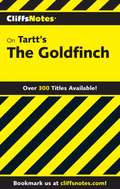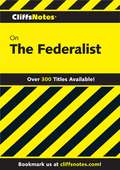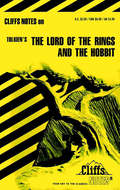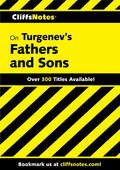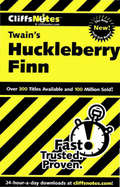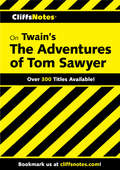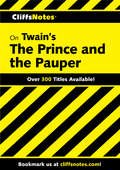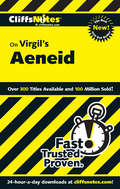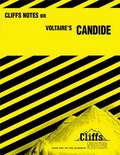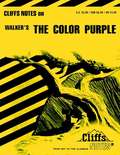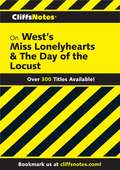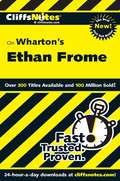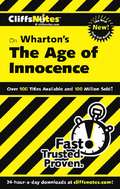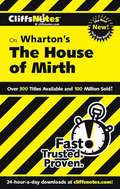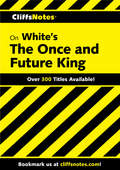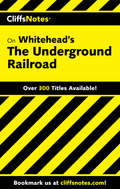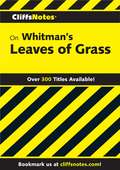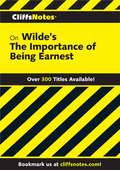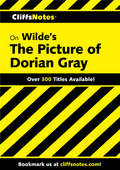- Table View
- List View
CliffsNotes on Tartt's The Goldfinch
by Abigail WheetleyCliffsNotes on Donna Tartt's The Goldfinch, winner of the 2014 Pulitzer Prize for Fiction, includes everything you've come to expect from the trusted experts at CliffsNotes, including summaries and analyses of Tartt's sprawling novel. Features of this Lit Note includeFocused summaries of the plot and analysis of important themes, symbols, and character developmentCharacter analyses of major characters, focusing on what motivates each characterBrief synopsis of the novelShort quiz
CliffsNotes on Tennyson's Idylls of the King
by Robert J MilchThis CliffsNotes guide includes everything you’ve come to expect from the trusted experts at CliffsNotes, including analysis of the most widely read literary works.
CliffsNotes on The Federalist
by George F WillisonThis CliffsNotes guide includes everything you've come to expect from the trusted experts at CliffsNotes, including analysis of the most widely read literary works.
CliffsNotes on Thoreau's Walden (Cliffs Notes Series)
by Joseph R McElrathThe original CliffsNotes study guides offer expert commentary on major themes, plots, characters, literary devices, and historical background. The latest generation of titles in this series also feature glossaries and visual elements that complement the classic, familiar format.In CliffsNotes on Walden, you discover the most important work of Henry David Thoreau—his exploration of the transcendentalist's striving to realize the possibility of one's own perfection and divinity. What results is an account of Thoreau's two-year stay at Walden Pond, as he celebrates nature as he moves toward spiritual rebirth and fulfillment.Chapter summaries and commentaries take you through Thoreau's journey, and essays help you understand the Transcendentalist movement and Thoreau's place in it. Other features that help you study includeA section on the life and background of Henry David ThoreauA section of essay questions and theme topicsA selected bibliographyClassic literature or modern-day treasure—you'll understand it all with expert information and insight from CliffsNotes study guides.
CliffsNotes on Thoreau, Emerson, and Transcendentalism
by Leslie P WilsonThe original CliffsNotes study guides offer expert commentary on major themes, plots, characters, literary devices, and historical background. The latest generation of titles in this series also feature glossaries and visual elements that complement the classic, familiar format.CliffsNotes on Thoreau, Emerson, and Transcendentalism explores in depth, but also in easy-to-understand terms, transcendentalism—the religious, political, and literary movement that captured the minds of such literary figures as Henry David Thoreau and Ralph Waldo Emerson in the first half of the 19th century. This guide helps you to understand the various tenets of transcendentalism, as well as how Thoreau and Emerson became the two most well-known figures associated with the movement and how the transcendentalist philosophy is reflected in their work.In addition to introducing you to the basics of understanding transcendentalism, this guide also gives you the following:Examinations of the lives of Thoreau and EmersonDetailed summaries of and commentaries on many of their transcendentalist writings, such as Emerson's Nature and Thoreau's WaldenCritical essays on Emerson and Thoreau's reputation and influenceA review section that tests your knowledgeA Resource Center full of books, articles, and Internet sitesClassic literature or modern-day treasure—you'll understand it all with expert information and insight from CliffsNotes study guides.
CliffsNotes on Tolkien's The Lord of the Rings & The Hobbit
by Gene B HardyJoin the journey through Middle-earth in the study guide of these two epic fantasies suggestive of life in medieval days, a classical battle between good and evil and the quest for a magical ring. This guide covers all four volumes of this unforgettable fantasy.
CliffsNotes on Turgenev's Fathers and Sons
by Denis M. CalandraThe CliffsNotes study guide on Turgenev's Fathers and Sons supplements the original literary work, giving you background information about the author, an introduction to the work, a graphical character map, critical commentaries, expanded glossaries, and a comprehensive index, all for you to use as an educational tool that will allow you to better understand the work. This study guide was written with the assumption that you have read Fathers and Sons. Reading a literary work doesn't mean that you immediately grasp the major themes and devices used by the author; this study guide will help supplement your reading to be sure you get all you can from Turgenev's Fathers and Sons. CliffsNotes Review tests your comprehension of the original text and reinforces learning with questions and answers, practice projects, and more. For further information on Turgenev's Fathers and Sons, check out the CliffsNotes Resource Center at www.cliffsnotes.com.
CliffsNotes on Twain's The Adventures of Huckleberry Finn
by Robert BruceThe original CliffsNotes study guides offer expert commentary on major themes, plots, characters, literary devices, and historical background. The latest generation of titles in this series also feature glossaries and visual elements that complement the classic, familiar format. In CliffsNotes on Huckleberry Finn, you follow the Mississippi River adventures of Mark Twain's mischief-making protagonist Huck Finn and the runaway slave Jim. Just like Huck's makeshift raft, this study guide carries you along on his incredible journey by providing chapter summaries and critical analyses on life in the late-19th-century American south. You'll also gain insight into the man behind this American classic -- Mark Twain, a.k.a. Samuel Clemens. Other features that help you study include Character analyses of major players A character map that graphically illustrates the relationships among the characters Critical essays A review section that tests your knowledge A Resource Center full of books, articles, films, and Internet sites Classic literature or modern modern-day treasure -- you'll understand it all with expert information and insight from CliffsNotes study guides.
CliffsNotes on Twain's The Adventures of Tom Sawyer
by James L RobertsThe original CliffsNotes study guides offer expert commentary on major themes, plots, characters, literary devices, and historical background. The latest generation of titles in this series also feature glossaries and visual elements that complement the classic, familiar format.In CliffsNotes on The Adventures of Tom Sawyer, you experience the exciting adventures of a typical boy during the mid-nineteenth century. The characters—Tom himself, Becky Thatcher, Huck Finn, Injun Joe, and Aunt Polly—have become part of American heritage.Use this study guide to help you discover all of Tom’s dreams and fears—and perhaps a few of your own! You'll also gain insight into the man behind this American classic—Mark Twain, a.k.a. Samuel Clemens. Other features that help you study include Character analyses of major playersA character map that graphically illustrates the relationships among the charactersCritical essaysA review section that tests your knowledgeA Resource Center full of books, articles, films, and Internet sitesClassic literature or modern-day treasure—you'll understand it all with expert information and insight from CliffsNotes study guides.
CliffsNotes on Twain's The Prince and the Pauper
by James L. Roberts L. David AllenThe CliffsNotes study guide on Twain's The Prince and the Pauper supplements the original literary work, giving you background information about the author, an introduction to the work, a graphical character map, critical commentaries, expanded glossaries, and a comprehensive index, all for you to use as an educational tool that will allow you to better understand the work. This study guide was written with the assumption that you have read The Prince and the Pauper. Reading a literary work doesn’t mean that you immediately grasp the major themes and devices used by the author; this study guide will help supplement your reading to be sure you get all you can from Twain's The Prince and the Pauper. CliffsNotes Review tests your comprehension of the original text and reinforces learning with questions and answers, practice projects, and more. For further information on Twain's The Prince and the Pauper, check out the CliffsNotes Resource Center at www.cliffsnotes.com.
CliffsNotes on Virgil's Aeneid
by Suzanne Pavlos Richard McdougallThe original CliffsNotes study guides offer expert commentary on major themes, plots, characters, literary devices, and historical background. The latest generation of titles in this series also features glossaries and visual elements that complement the classic, familiar format.CliffsNotes on Aeneid takes you on the journey of a band of survivors who leave their destroyed city to seek another home in a faraway country. Woven from myth and legend, the story is about rebirth, about life springing forth from ruin and death.This study guide will help navigate the voyages of the Trojans and uncover their significance in Virgil's time and today. You'll also gain insight into the life and cultural background of the author. Other features that help you study includeCharacter analyses of major playersA character map that graphically illustrates the relationships among the charactersCritical essaysA review section that tests your knowledgeA Resource Center full of books, articles, films, and Internet sitesClassic literature or modern modern-day treasure -- you'll understand it all with expert information and insight from CliffsNotes study guides.
CliffsNotes on Voltaire's Candide
by Francois Marie Arouet James K LowersThe original CliffsNotes study guides offer expert commentary on major themes, plots, characters, literary devices, and historical background.CliffsNotes on Candide explores the best known philosophic tale from Voltaire. The tale is a vehicle for his profoundest views on politics, religion, and philosophy. At the same time, it is an adventure tale about a young hero who travels far and wide and experiences great dangers.With this study guide, you'll see why Voltaire is considered among the greatest satirists in literature. Along with detailed explanations of the plot, your understanding will increase with insight into the life and times of the author. Other features that help you study includeBackground on Voltaire's contemporaries and influencesCharacter analyses of major playersA character map that graphically illustrates the relationships among the charactersCritical essaysReview questionsClassic literature or modern modern-day treasure -- you'll understand it all with expert information and insight from CliffsNotes study guides.
CliffsNotes on Vonnegut's Slaughterhouse-Five
by Dennis S SmithAn odd book in that it mixes elements of science fiction with psychological analysis, Slaughterhouse-Five tells the story of Billy Pilgrim, a GI prisoner of war. He time-travels and wanders through a mysterious ether where spatial-temporal relationships are at odds with what we accept as reality.
CliffsNotes on Walker's The Color Purple
by Gloria RoseThe original CliffsNotes study guides offer expert commentary on major themes, plots, characters, literary devices, and historical background.In CliffsNotes on The Color Purple, you follow the beautiful and difficult story of a shy and abused Southern black woman's struggle to create an identity, a feeling of self-worth, and love. Covering a series of personal letters that span a 40-year period, this study guide shares a story about growth, endurance, loyalty, solidarity, and joy -- all nurtured by the strength of love. You'll gain comfort with the black folk language main character Celie's uses to express herself as you move through critical commentaries on each of the novel's 89 letters. Other features that help you figure out this important work includeLife and background of the author, Alice WalkerAnalyses of a large cast of charactersIntroduction to the novelA review section that tests your knowledge and suggests essay topicsA selected bibliography that leads you to more great resourcesClassic literature or modern-day treasure -- you'll understand it all with expert information and insight from CliffsNotes study guides.
CliffsNotes on Warren's All the King's Men
by L. David AllenThis CliffsNotes guide includes everything you've come to expect from the trusted experts at CliffsNotes, including analysis of the most widely read literary works.
CliffsNotes on West’s Miss Lonelyhearts & The Day of the Locust
by Mordecai MarcusThe original CliffsNotes study guides offer expert commentary on major themes, plots, characters, literary devices, and historical background OCo all to help you gain greater insight into great works you're bound to study for school or pleasure. "CliffsNotes on West's Miss Lonelyhearts & The Day of the Locust" offers a close look at the painstaking craftsmanship of Nathanael West's two best novels, which provide material for engrossing entertainment and serious thought. Each of these books demonstrates West's incisive psychological and social probing into how society can crush or leave empty all who live in it. In this study guide, you'll find Life and Background of the Author, Introductions to the Novels, Lists of Characters, and more: Critical CommentariesCharacter AnalysesCritical EssaysEssay Topics and Review QuestionsSelected BibliographyClassic literature or modern-day treasure OCo you'll understand it all with expert information and insight from CliffsNotes study guides. "
CliffsNotes on Wharton's Ethan Frome
by Suzanne PavlosThe original CliffsNotes study guides offer a look into key elements and ideas within classic works of literature. The latest generation of titles in this series also features glossaries and visual elements that complement the familiar format.CliffsNotes on Ethan Frome explores life in the personal prison designed by the lead character, a "ruin of a man" who would rather be miserable with his lot in life than stray from accepted social convention.Following the story of a poor farmer whose devotion to duty and fear of humiliation keep him from tasting happiness, this study guide provides summaries and commentaries for each chapter within this tragic tale. Other features that help you figure out this important work includeLife and background of author Edith WhartonIntroduction to the novel, with a synopsis and character mapFull character list and analyses of central figuresCritical essays on the author's style, choice of literary tools, and use of themesReview section that features fill-in-the-blank questions, quoted passages, essay questions, and suggested practice projectsResourceCenter with books, articles, and Web sites that can help round out your knowledgeClassic literature or modern-day treasure -- you'll understand it all with expert information and insight from CliffsNotes study guides.
CliffsNotes on Wharton's The Age of Innocence
by Susan Van KirkGet the most from great literature with CliffsNotes, the original study guides.Written exclusively by experienced teachers and educators, CliffsNotes are the resource of choice for today's students. These user-friendly guides make studying a snap - with visual icons flagging key themes, literary devices, and more.Inside you'll find valuable insights on Wharton's The Age of Innocence, including:Brief overall synopsisChapter-by-chapter summariesClear explanations and analysisCharacter map-who's who at a glanceCharacter analysis (Newland Archer, May Welland Archer, Countess Ellen Olenska, Mrs. Manson Mingott)Concise discussion of major themesSpecial essay on the book's themes, including personal freedom, values, and social codesReview Q&As and quote IDsEssay questions and practice projectsGlossaries of key words and terms
CliffsNotes on Wharton's The House of Mirth
by Bruce E WalkerThe original CliffsNotes study guides offer expert commentary on major themes, plots, characters, literary devices, and historical background. The latest generation of titles in this series also feature glossaries and visual elements that complement the classic, familiar format.CliffsNotes on The House of Mirth takes you into the waning years of the Gilded Age and the moral bankruptcy of New York City's elite class. Edith Wharton's story of a woman — whose beauty causes men to desire to possess her and women to be jealous of her — reflects the complicated struggle of the individual against the social strictures of a powerful, and triumphant, moneyed class.This concise supplement to the satirically critical The House of Mirth, helps you understand the overall structure of the novel, actions and motivations of the characters, and the social and cultural perspectives of the author. Features that help you study includeChapter-by-chapter summaries and commentariesA character map that outline key characteristics and relationshipsInsightful character analysesA critical essay about the opulence and emptiness of the Gilded AgeA review section that tests your knowledgeClassic literature or modern modern-day treasure — you'll understand it all with expert information and insight from CliffsNotes study guides.
CliffsNotes on White's The Once and Future King
by Daniel MoranThe original CliffsNotes study guides offer expert commentary on major themes, plots, characters, literary devices, and historical background. The latest generation of titles in this series also feature glossaries and visual elements that complement the classic, familiar format.Based on medieval Arthurian legends, CliffsNotes on The Once and Future King is a twentieth-century version of young Arthur's quest for the sword Excalibur and his claim to the throne of England. Including many well-known and much-loved episodes with Merlyn, the sorcerer; Morgan La Fay, the witch; and knights jousting and hounds engaged in the hunt, White's novel adds to the lore surrounding the person of King Arthur.This study guide covers all four volumes of The Once and Future King with special emphasis given to the most popular volume, The Sword in the Stone. Other features that help you study includeCharacter analyses of major playersPersonal background of the author, T.H. WhiteA critical essay on Arthurian filmsA review section that tests your knowledgeA Resource Center full of books, articles, and websitesClassic literature or modern-day treasure—you'll understand it all with expert information and insight from CliffsNotes study guides.
CliffsNotes on Whitehead's The Underground Railroad
by Gregory ColesCliffsNotes on Colson Whitehead's The Underground Railroad includes summaries and analyses of this 2016 National Book Award winning novel about the Underground Railroad and one slave's heroic struggle to gain her freedom via a "real" fictional Underground Railroad.
CliffsNotes on Whitman's Leaves of Grass
by V. A. ShahaneThis CliffsNotes guide includes everything you’ve come to expect from the trusted experts at CliffsNotes, including analysis of the most widely read literary works.
CliffsNotes on Wiesel's Night
by Maryam RiessThe original CliffsNotes study guides offer expert commentary on major themes, plots, characters, literary devices, and historical background.In CliffsNotes on Night, you follow the humanistic first-person account of a teenage boy's incarceration by the Nazi Secret Service in World War II; his experiences in the Auschwitz and Buchenwald death camps; and his struggle to find meaning among the horror.Covering little more than a year of the young narrator's life, this study guide shares a story about endurance, loyalty, and faith — all nurtured by the strength of love. Other features that help you figure out this important work includeLife and background of the author, Dr. Elie WieselA list of charactersA historical timeline of Nazi GermanyA review section that tests your knowledge and suggests essay topicsA selected bibliography that leads you to more great resourcesClassic literature or modern-day treasure — you'll understand it all with expert information and insight from CliffsNotes study guides.
CliffsNotes on Wilde's The Importance of Being Earnest
by Susan Van KirkThe original CliffsNotes study guides offer a look into critical elements and ideas within classic works of literature. The latest generation of titles in this series also feature glossaries and visual elements that complement the classic, familiar format. CliffsNotes on The Importance of Being Earnest offers a concise look at this Victorian farce, which tweaks the complacency and aristocratic attitudes prevalent among the wealthy upper class of the time. Hidden identities, fierce repartee, underlying passions, and surprises punctuate this lively play. This study guide shows, through its expert commentaries, just how three sets of lovers clear up mishap and misunderstandings and end up happily ever after. Other features that help you figure out this survey of Victorian social issues include:A close look at the author's life, which itself was rife with scandal and ruinSummaries and commentaries, act by actDescriptive character analysesA character map that reveal key relationshipsCritical essays on Victorian views on compassion, religion, marriage, and moreA review section that tests your knowledge, and suggested essay topics Classic literature or modern-day treasure—you'll understand it all with expert information and insight from CliffsNotes study guides.
CliffsNotes on Wilde's The Picture of Dorian Gray
by Stanley P BaldwinThe original CliffsNotes study guides offer expert commentary on major themes, plots, characters, literary devices, and historical background. The latest generation of titles in this series also feature glossaries and visual elements that complement the classic, familiar format.In CliffsNotes on The Picture of Dorian Gray, you explore Oscar Wilde’s great works about narcissism, rife with symbolism and classic themes. Here, you meet Dorian Gray and discover his secret pact with the devil to stay young and handsome, and the subsequent destruction of his soul.This study guide carefully walks you through Dorian’s story by providing summaries and critical analyses of each chapter of the novel. You'll also explore the life and background of the author, Oscar Wilde, and gain insight into how he came to write this novel. Other features that help you study includeA list of charactersGlossaries to define new and unfamiliar termsCritical essays about Oscar Wilde’s views and lifeA review section that tests your knowledgeA list of online resources for more studyClassic literature or modern-day treasure—you'll understand it all with expert information and insight from CliffsNotes study guides.
